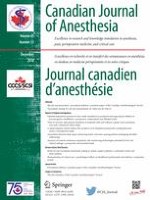Published in:

01-12-2018 | Reports of Original Investigations
A rapid response system reduces the incidence of in-hospital postoperative cardiopulmonary arrest: a retrospective study
Authors:
Tak Kyu Oh, MD, Sooyeon Kim, MS, Dong Seon Lee, RN, Hyunju Min, RN, Yun Young Choi, RN, Eun Young Lee, RN, Mi-Ae Yun, RN, Yeon Joo Lee, MD, Park Sang Hon, MD, PhD, Kyuseok Kim, MD, PhD, Sang-Hwan Do, MD, PhD, Jung-Won Hwang, MD, PhD, In-Ae Song, MD, PhD
Published in:
Canadian Journal of Anesthesia/Journal canadien d'anesthésie
|
Issue 12/2018
Login to get access
Abstract
Purpose
Rapid response systems (RRSs) have been introduced into hospitals to help reduce the incidence of sudden cardiopulmonary arrest (CPA). This study evaluated whether an RRS reduces the incidence of in-hospital postoperative CPA.
Methods
This retrospective before-and-after analysis evaluated data collected from electronic medical records during a pre-intervention (January 2008 to September 2012) and post-intervention (implementation of an RRS) interval (October 2012 to December 2016) at a single tertiary care institution. The primary outcome was a change in the rate of CPA in surgical patients recovering in a general ward. A Poisson regression analysis adjusted for the Charlson Comorbidity Index (CCI) was used to compare CPA rates during these two intervals.
Results
Of the 207,054 surgical procedures performed during the study period, mean (95% confidence interval [CI]) CPA events per 10,000 cases of 7.46 (5.72 to 9.19) and 5.19 (3.85 to 6.52) were recorded before and after RRS intervention, respectively (relative risk [RR], 0.73; 97.5% CI, 0.48 to 1.13; P = 0.103). Cardiopulmonary arrest incidence was reduced during RRS operational hours of 07:00–22:00 Monday-Friday and 07:00–12:00 Saturday (RR, 0.56; 97.5% CI, 0.31 to 1.02; P = 0.027) but was unchanged when the RRS was not operational (RR, 0.86; 97.5% CI, 0.52 to 1.40; P = 0.534). The CCI-adjusted RR of CPA after RRS implementation was lower than before RRS intervention (0.63; 97.5% CI, 0.41 to 0.98; P = 0.018) but this reduction was still only apparent during RRS operational hours (RR, 0.48; 97.5% CI, 0.27 to 0.89; P = 0.008 vs RR, 0.85; 97.5% CI, 0.45 to 1.58; P = 0.55).
Conclusion
Implementation of an RRS reduced the incidence of postoperative CPA in patients recovering in a general ward. Furthermore, this reduction was observed only during RRS operational hours.





